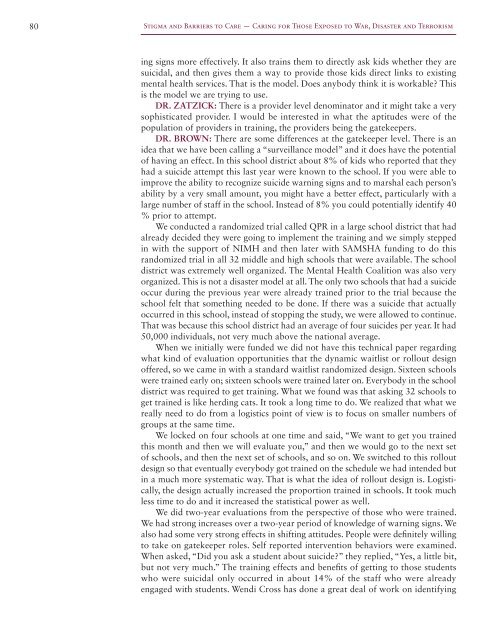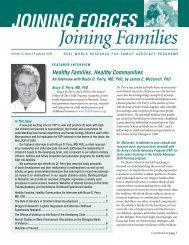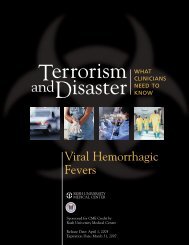stigma and barriers to care - Uniformed Services University of the ...
stigma and barriers to care - Uniformed Services University of the ...
stigma and barriers to care - Uniformed Services University of the ...
Create successful ePaper yourself
Turn your PDF publications into a flip-book with our unique Google optimized e-Paper software.
80<br />
Stigma <strong>and</strong> Barriers <strong>to</strong> Care — Caring for Those Exposed <strong>to</strong> War, Disaster <strong>and</strong> Terrorism<br />
ing signs more effectively. It also trains <strong>the</strong>m <strong>to</strong> directly ask kids whe<strong>the</strong>r <strong>the</strong>y are<br />
suicidal, <strong>and</strong> <strong>the</strong>n gives <strong>the</strong>m a way <strong>to</strong> provide those kids direct links <strong>to</strong> existing<br />
mental health services. That is <strong>the</strong> model. Does anybody think it is workable This<br />
is <strong>the</strong> model we are trying <strong>to</strong> use.<br />
DR. ZATZICK: There is a provider level denomina<strong>to</strong>r <strong>and</strong> it might take a very<br />
sophisticated provider. I would be interested in what <strong>the</strong> aptitudes were <strong>of</strong> <strong>the</strong><br />
population <strong>of</strong> providers in training, <strong>the</strong> providers being <strong>the</strong> gatekeepers.<br />
DR. BROWN: There are some differences at <strong>the</strong> gatekeeper level. There is an<br />
idea that we have been calling a “surveillance model” <strong>and</strong> it does have <strong>the</strong> potential<br />
<strong>of</strong> having an effect. In this school district about 8% <strong>of</strong> kids who reported that <strong>the</strong>y<br />
had a suicide attempt this last year were known <strong>to</strong> <strong>the</strong> school. If you were able <strong>to</strong><br />
improve <strong>the</strong> ability <strong>to</strong> recognize suicide warning signs <strong>and</strong> <strong>to</strong> marshal each person’s<br />
ability by a very small amount, you might have a better effect, particularly with a<br />
large number <strong>of</strong> staff in <strong>the</strong> school. Instead <strong>of</strong> 8% you could potentially identify 40<br />
% prior <strong>to</strong> attempt.<br />
We conducted a r<strong>and</strong>omized trial called QPR in a large school district that had<br />
already decided <strong>the</strong>y were going <strong>to</strong> implement <strong>the</strong> training <strong>and</strong> we simply stepped<br />
in with <strong>the</strong> support <strong>of</strong> NIMH <strong>and</strong> <strong>the</strong>n later with SAMSHA funding <strong>to</strong> do this<br />
r<strong>and</strong>omized trial in all 32 middle <strong>and</strong> high schools that were available. The school<br />
district was extremely well organized. The Mental Health Coalition was also very<br />
organized. This is not a disaster model at all. The only two schools that had a suicide<br />
occur during <strong>the</strong> previous year were already trained prior <strong>to</strong> <strong>the</strong> trial because <strong>the</strong><br />
school felt that something needed <strong>to</strong> be done. If <strong>the</strong>re was a suicide that actually<br />
occurred in this school, instead <strong>of</strong> s<strong>to</strong>pping <strong>the</strong> study, we were allowed <strong>to</strong> continue.<br />
That was because this school district had an average <strong>of</strong> four suicides per year. It had<br />
50,000 individuals, not very much above <strong>the</strong> national average.<br />
When we initially were funded we did not have this technical paper regarding<br />
what kind <strong>of</strong> evaluation opportunities that <strong>the</strong> dynamic waitlist or rollout design<br />
<strong>of</strong>fered, so we came in with a st<strong>and</strong>ard waitlist r<strong>and</strong>omized design. Sixteen schools<br />
were trained early on; sixteen schools were trained later on. Everybody in <strong>the</strong> school<br />
district was required <strong>to</strong> get training. What we found was that asking 32 schools <strong>to</strong><br />
get trained is like herding cats. It <strong>to</strong>ok a long time <strong>to</strong> do. We realized that what we<br />
really need <strong>to</strong> do from a logistics point <strong>of</strong> view is <strong>to</strong> focus on smaller numbers <strong>of</strong><br />
groups at <strong>the</strong> same time.<br />
We locked on four schools at one time <strong>and</strong> said, “We want <strong>to</strong> get you trained<br />
this month <strong>and</strong> <strong>the</strong>n we will evaluate you,” <strong>and</strong> <strong>the</strong>n we would go <strong>to</strong> <strong>the</strong> next set<br />
<strong>of</strong> schools, <strong>and</strong> <strong>the</strong>n <strong>the</strong> next set <strong>of</strong> schools, <strong>and</strong> so on. We switched <strong>to</strong> this rollout<br />
design so that eventually everybody got trained on <strong>the</strong> schedule we had intended but<br />
in a much more systematic way. That is what <strong>the</strong> idea <strong>of</strong> rollout design is. Logistically,<br />
<strong>the</strong> design actually increased <strong>the</strong> proportion trained in schools. It <strong>to</strong>ok much<br />
less time <strong>to</strong> do <strong>and</strong> it increased <strong>the</strong> statistical power as well.<br />
We did two-year evaluations from <strong>the</strong> perspective <strong>of</strong> those who were trained.<br />
We had strong increases over a two-year period <strong>of</strong> knowledge <strong>of</strong> warning signs. We<br />
also had some very strong effects in shifting attitudes. People were definitely willing<br />
<strong>to</strong> take on gatekeeper roles. Self reported intervention behaviors were examined.<br />
When asked, “Did you ask a student about suicide” <strong>the</strong>y replied, “Yes, a little bit,<br />
but not very much.” The training effects <strong>and</strong> benefits <strong>of</strong> getting <strong>to</strong> those students<br />
who were suicidal only occurred in about 14% <strong>of</strong> <strong>the</strong> staff who were already<br />
engaged with students. Wendi Cross has done a great deal <strong>of</strong> work on identifying




